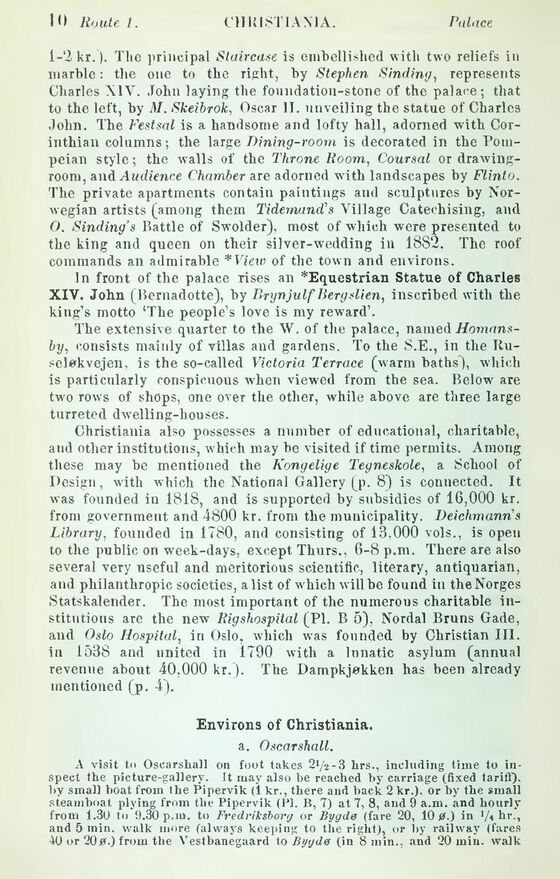
Full resolution (JPEG) - On this page / på denna sida - Norway - Pages ...

<< prev. page << föreg. sida << >> nästa sida >> next page >>
Below is the raw OCR text
from the above scanned image.
Do you see an error? Proofread the page now!
Här nedan syns maskintolkade texten från faksimilbilden ovan.
Ser du något fel? Korrekturläs sidan nu!
This page has never been proofread. / Denna sida har aldrig korrekturlästs.
1-2 kr.). The principal Staircase is embellished with two reliefs in
marble: the one to the right, by Stephen Binding, represents
Charles X1Y. John laying the fonndation-stone of the palace; that
to the left, by M. Skeibrok, Oscar HI. unveiling the statue of Charles
John. The Festsal is a handsome and lofty hall, adorned with
Corinthian columns; the large Dining-room is decorated in the
Pompeian style; the walls of the Throne Room, Coursal or
drawingroom, and Audience Chamber are adorned with landscapes by Flinto.
The private apartments contain paintings and sculptures by
Norwegian artists (among them Tidemand’s Village Catechising, and
O. Sinding’s Rattle of Swolder), most of which were presented to
the king and queen on their silver-wedding in 18S2. The roof
commands an admirable *View of the town and environs.
In front of the palace rises an *Equestrian Statue of Charles
XIV. John (Bernadotte), by Brynjulf Berg slien, inscribed with the
king’s motto ‘The people’s love is my reward’.
The extensive quarter to the \V. of the palace, named
Homans-by, consists mainly of villas and gardens. To the S.E., in the
Itu-selokvejen, is the so-called Victoria Terrace (warm baths), which
is particnlarly conspicuous when viewed from the sea. Below are
two rows of shops, one over the other, while above are three large
turreted dwelling-houses.
Christiania also possesses a number of educational, charitable,
and other institutions, which may be visited if time permits. Among
these may be mentioned the Kongelige Tegneskole, a School of
Design, with which the National Gallery (p. 8) is connected. It
was founded in 1818, and is supported by subsidies of 16,000 kr.
from government and 4800 kr. from the municipality. Deichmann’s
Library, founded in 1780, and consisting of 13,000 vols., is open
to the public on week-days, except Thurs., 6-8 p.m. There are also
several very useful and meritorious scientific, literary, antiquarian,
and philanthropic societies, a list of which will be found in the Norges
Statskalender. The most important of the numerous charitable
institutions are the new Rigshospital (Pl. B 5), Nordal Bruns Gade,
and Oslo Hospital, in Oslo, which was founded by Christian III.
in 1538 and united in 1790 with a lunatic asylum (annual
revenue about 40,000 kr.). The Dampkjekken has been already
mentioned (p. 4).
Environs of Christiania.
a. Oscarshall.
A visit to Oscarshall on foot takes 2i/2-3 hrs., including time to
inspect the picture-gallery. It may also be reached by carriage (fixed tariff),
by small boat from the Pipervik (1 kr., there and back 2 kr.), or by the small
steamboat plying from the Pipervik (Pl. B, 7) at 7, 8, and 9 a.m. and hourly
from f.30 to 9.30 p.m. to Fredriksborg or Bygde (fare 20, 10 0.) in >/< hr.,
and 5 min. walk more (always keeping to the right), or by railway (fares
40 or 20ø.) from the Vestbanegaard to Bygde (in 8 min., and 20 min. walk
<< prev. page << föreg. sida << >> nästa sida >> next page >>